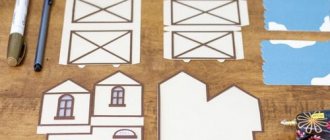DIY Wind Water Pump
This water pump is definitely in beta testing.
All components work, but the design is extremely inefficient and requires significant wind to pump water out of our pond. In the video below I play out part of the storm to give you an idea of how the pump works. The last step of this tutorial will discuss the mistakes in the current project and how they can be improved to use wind energy more efficiently. SEE FINAL STEP FOR FULL UNDERSTANDING AND VIDEO OF THE WORKING PUMP.
Products for inventors Link to the store.
Installation Features
The windmill is usually installed on a hillock, not far from the house, but so that no buildings block the wind. In our case, installation is carried out above the well, which eliminates the choice of the optimal location. Tying to a well forces you to put up with the possible presence of wind interference, or to make a higher mast that allows you to raise the windmill above the obstacle. This point must be taken into account at the installation design stage in order to immediately assemble a mast of the required height, eliminating the need for alterations or design changes.
Wind turbine device
The wind turbine design used for such a pump must be most efficient and sensitive to relatively light winds. There are two main types of wind turbines:
- horizontal
- vertical
Horizontal designs are considered more successful, since they use the energy of the wind flow much more efficiently than vertical wind turbines.
At the same time, to create a horizontal structure, it is necessary to ensure free rotation of the entire assembly around a vertical axis for homing into the wind. This results in two moving elements on one unit, which complicates the design.
Vertical windmills do not need guidance, since the direction of the wind does not matter to them, only the speed. At the same time, the flow simultaneously affects both sides of the blades, causing the rotation efficiency to decrease. There are different designs of such wind turbines, created to increase efficiency:
- Savonius rotor
- Daria rotor
- Lenz rotor
- orthogonal rotor
- helicoid rotor, etc.
Research in this area is ongoing, many engineers are busy solving the problem, so every year new versions with greater efficiency are announced. Thus, a structure was created from several blades, half covered with a special casing that hides the reverse sides of the blades from the wind flow.
The casing rotates freely around a vertical axis, but is not connected to the impeller. It has a stabilizer similar to the tail of an airplane, which adjusts the position of the protection when the wind direction changes. There are other designs that have certain advantages, but so far no one has achieved any significant success.
How to make a windmill yourself
Self-manufacturing of a windmill usually follows the following scheme:
- choice of design type
- creation of a project (working drawing)
- purchasing or sourcing materials
- rotating shaft assembly
- installing blades on it
- mast creation
- wind turbine assembly and installation
These stages are arbitrary; in each specific case, work is carried out in a way that is convenient for the master, but adhering to such a scheme is the most rational way of action.
The best option is a horizontal design, so it is better to choose it. To create it, you will need a horizontal shaft, blades diverging from the center like the wings of a mill, and a device for transmitting rotation to the crank. Typically, a rotating impeller is made, mounted on a turntable with a stabilizer, self-guided towards the flow. Rotation is transmitted by gear or chain transmission, depending on the capabilities or availability of one or the other device.
The dimensions of the blades should ensure that rotation starts at a relatively low wind, usually 33-5 m/s, but there are samples that start at lower flow speeds. For example, the Onipko rotor, according to the inventor, begins to rotate at a speed of 1.4 m/s, which is very attractive for regions with a calm atmosphere. There is also the recently introduced Tretyakov rotor, a rather complex design that captures the flow and organizes it so that it completely affects the impeller without loss. These designs are quite difficult to make on your own, as they have a lot of curved parts of a specific shape, which is difficult to replicate at home.
How to make your own pump
If there is no ready and working pump, then you have to get out of the situation by any available means. Usually a ready-made but not working pump from a car (mechanical) is used, the compressor is rebuilt, in a word, any more or less suitable device that is available is used. If there is nothing suitable, you will have to assemble the pump from scratch.
The simplest pump design
The easiest (and most reliable) way is to use the most primitive, and therefore trouble-free design of a conventional pump. It is a cylinder, the lower part of which has a jumper with a suction pipe and a check valve. A piston moves up and down inside the cylinder, the bottom of which is also equipped with a check valve. When the piston moves upward, a vacuum is created in the suction pipe, as a result of which the cavity between the bottom and the piston is filled with water. Both valves are closed.
With the subsequent downward movement, the piston begins to pass water upward through its valve, and the lower valve closes, preventing water from escaping downwards. When the water reaches a certain level, it pours out through the outlet pipe, spout or other openings.
What determines the quality of pump operation?
The quality of operation of such a pump directly depends on the tightness of all elements. If the piston moves tightly enough and does not allow water to enter the gap between the cylinder walls and its sealing ring, then the device is capable of lifting water to a height of up to 8 m.
To make such a pump, you will need a sleeve and a piston with an o-ring. The trick is that the denser the piston, the greater the force required to operate it, which will require an increase in the power of the windmill. This path is a dead end, since only a hurricane-force wind can move a heavy windmill, so it is necessary to select the mechanics of the pump so that it does not require too much effort.
In addition, serious attention must be paid to the operation of check valves. They should operate very easily, without effort, but block the path of water quite reliably. Conventional gravity valves, or more reliable spring-loaded designs that do not “stick” in the open position, can be used.
The quality of the check valves determines the operation of the pump even more than the density of the piston.
What can a pump be made from?
The pump can be made from various materials:
- metal
- plastic
The choice is not very extensive, but in this case a long list is not required. A metal pump is stronger and more reliable, but its manufacture will require access to lathe equipment. In addition, the material for the manufacture of device parts should be metals that are not subject to corrosion - stainless steel, duralumin or brass. This is the first and main condition, the observance of which makes the pump strong and durable.
It is not recommended to use ready-made pipes, since the internal profile does not always have an ideal round shape, which threatens to reduce pump performance. You can use ready-made parts from other devices that are suitable in shape and size, if available.
DIY plastic pumps At the same time, in winter they become fragile and can simply burst. This circumstance must be kept in mind and try to somehow solve the problem before the onset of cold weather. Assembling the pump is possible with your own hands without contacting a workshop or specialized organization, since the starting material is usually polypropylene water or sewer pipes, which have various components that exactly fit them in size.
All that remains for the master is to select the most suitable elements, make a sleeve and piston, cover the lower part of the sleeve with a plug and connect it to the suction pipe. As a check valve, you can use ordinary rubber attached to one end of the plug. When the piston moves up, it will rise, allowing water to pass through, and when it moves down, it will fall and block the outlet. The performance of such a pump is usually somewhat lower, but, in general, it all depends on the accuracy and quality of workmanship.
Batteries for a wind generator: another problem for the home owner
One of the costly challenges of a wind or solar power plant is the problem of storing electricity, which only batteries solve. They will need to be purchased and updated, and the cost is quite high.
To select them, you need to know the operating characteristics - voltage and capacitance. Typically, composite batteries from a 12 V battery are used, and the number of ampere-hours in each specific case should be determined empirically, based on the power of consumers and their operating time.
You will need to choose batteries for a wind generator from a fairly wide range. I will not limit myself to a full review, but to just four popular types of acid batteries:
- normal car starting;
- Type AGM;
- gel;
- armored.
Sellers do not recommend purchasing starter batteries for wind power plants, since they are designed to operate in critical vehicle operating conditions:
- when stored in the cold, they must withstand the enormous starting currents that arise when starting a cold engine;
- during movement they are subject to vibration and shaking;
- Charging occurs in buffer mode by the generator while the vehicle is moving at different engine speeds.
In which:
- reconditioned batteries, requiring periodic electrolyte levels and topping up with distilled water, are designed for 100 discharge/charge cycles;
- without major repairs - they have a more complex design and the number of cycles is 200.
However, the windmill battery when working inside the house:
- usually placed in the basement, where the temperature, maintained all year round at + 5 ÷ + 10 degrees, is optimal;
- they are not subject to shaking and vibration, they are permanently installed in a stable state;
- they do not receive extreme loads during startup, and when turning on household appliances through the inverter, they work delicately;
- they are charged by the generator with small currents, which have a beneficial effect on the desulfation mode of the plates.
All these are the most favorable conditions for their operation. Therefore, I propose to note this option for those who are not too lazy to periodically monitor the voltage on the banks and monitor the electrolyte level in them.
AGM batteries have a more complex design. They have the same plates, but glass mats are impregnated with acid, which simultaneously act as a dielectric layer. Their discharge/charge cycle is 250 ÷ 400. Overcharging is dangerous.
Gas batteries are also created from a maintenance-free design with a sealed housing and gel electrolyte. They don't really like charging, but are more resistant to deep discharges. Number of calculation cycles – 350.
Armored batteries are among the most modern developments. Their electrode pads are protected by polymers from acid attack. Duty cycle interval: 900 ÷ 1500.
All four types of batteries differ significantly in price and operating conditions. If you take into account the sellers' recommendations, you will have to shell out a pretty decent amount of money.
However, I recommend that you first listen to the useful advice that the owner of solar panels himself gives in his video “How to choose batteries for a wind farm and solar station.”
He has his own opinion on this matter. How you feel about him is your business. However, getting acquainted with information from opposing sources and choosing the most suitable option from it is the optimal solution for a thinking person.
Main types of wind generators: vertical, horizontal
31861 February 1, 2017
Wind turbines use the power and strength of the wind to produce electrical energy. Modern human life is unthinkable without
electricity, even in areas remote from electricity supply. Wind producers of environmentally friendly light energy serve as an alternative source.
And they are gaining more and more popularity every year. The larger the range of products, the more questions arise about which type of wind generator to prefer. Both in terms of performance and money.
Main types of wind generators
Models of wind generators come in different designs and differ in power. According to the rotation geometry of the main rotor axis, they are divided into:
- Vertical type - the turbine is located vertically relative to the ground plane. Starts working in light winds.
- Horizontal type - the rotor axis rotates parallel to the earth's surface. It has great power to convert wind energy into alternating and direct current.
Let's look at these types in more detail, since each of them has developments and improvements.
Types of vertical generators (carousel type)
Vertical wind power converters are often used for domestic purposes. These types of wind generators are easy to maintain. The main components that require attention are located at the bottom of the installations and are free to access.
Generators with Savounis rotor
Consist of two cylinders. Constant axial rotation and wind flow are not dependent on each other. Even with sudden gusts, it spins at the initially set speed.
The absence of wind influence on the rotation speed is undoubtedly a good advantage. The bad thing is that he uses the power of the element not to its full power, but only to a third. The design of the blades in the form of semi-cylinders allows you to operate only a quarter of a turn.
Generators with Daria rotor
They have two or three blades. Easy to install. The design is simple and clear. They start working from manual start.
The downside is that the turbines are not very powerful. Strong vibration causes loud noise. This is facilitated by a large number of blades.
Helicoid rotor
The wind generator rotates evenly thanks to the twisted blades. Bearings are not subject to rapid wear, which significantly extends their service life.
Installing the unit takes time and is fraught with assembly difficulties. Complex manufacturing technology resulted in a high price.
Multi-blade rotor
The vertical-axis design with a large number of blades makes it sensitive to even very light winds. The efficiency of such wind generators is very high.
This is a powerful converter. Wind energy is used to the maximum. It's expensive. Disadvantage: high background sound. Can produce a large amount of electric current.
Orthogonal rotor
Begins to generate energy at a wind speed of 0.7 m/sec. Consists of a vertical axis and blades. Doesn't make much noise and has a beautiful, unusual design. Service life is several years.
The heavy weight of the blade makes it bulky, which complicates installation work.
The positive aspects of vertical wind generators:
- The use of generators is possible even in low winds.
- They do not adjust to wind currents, as they do not depend on its direction.
- They are installed on a short mast, which allows servicing of systems on the ground.
- Noise within 30 dB.
- Varied, pleasant appearance.
A little physics for those who decide to seriously tackle the problem of water supply
The operation of a submersible pump is based on the rotational movements of a crank mechanism. A conventional wind generator allows the device to be put into operation. Its effectiveness has been proven by the practical experience of many summer residents who were able to understand the nuances of the mechanism and design it themselves. Indeed, despite its apparent complexity, you can assemble a wind pump with your own hands quite quickly and at minimal cost. The only condition is that when performing calculations and developing drawings, it is important to take into account several points:
Experience shows that the initial choice in favor of a large wind generator eventually makes you think about purchasing or manufacturing a medium-sized device. Some power losses in this case are compensated by the stable operation of the windmill even at low air flow speeds. Moreover, in most parts of the country strong winds are observed relatively rarely.











